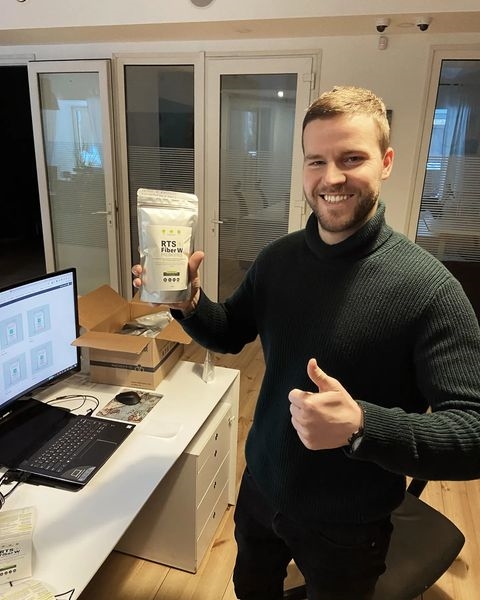How I Turned the Mistakes of My First Startup into Wins for My Second One

When I founded my first company, Grafomap, I was an idealist. But, like many freshly baked entrepreneurs, I saw this personalized map poster startup almost as my own child and felt the need to take care of it nearly 24/7.
To further blur the line between my personal and professional life, Grafomap was born out of a friendship with my childhood friend Martins. However, with time, I realized that my company had become my work and my child, hobby, and pastime.
When I started with Supliful last year, I had learned a few painful lessons, and this time I was determined to approach business management with a more balanced and composed mindset. This is a story of how I faced entrepreneur burnout and how this painful experience taught me to become a smarter business leader the second time around.
I didn’t know what burnout was until it hit me — Hard
At Grafomap, my responsibility was all things marketing, but somehow I became involved in sales processes, human resources, accounting, and other areas. So it’s probably not surprising that, after working at full speed for several months, exhaustion and burnout crept up on me. I felt constantly anxious and insecure, having doubts whether the business would stay afloat for another month.
Looking back, I think these were the main factors that caused me to hit the wall:
- First, micromanaging and trying to become involved in almost every process.
- Taking all the opportunities that came my way and not filtering the valuable ones from mere time-wasters.
- Long working hours and not knowing how to separate work from private life.
Two years into developing Grafomap, I felt I had hit rock bottom. The business model was seriously lacking repeat purchases. A constant need to find new sales channels, new ideas, and approaches for attracting customers was tiring and frustrating. A business must find a way to acquire repeat customers for better profitability. The one-and-done model is the way to go insane.
As we were slowly going bankrupt (up to the point of taking personal loans to save the business), we sat down and refocused our priorities and stayed only with a few marketing and sales tactics that had proven to be effective. We managed to grow Grafomap to $ 1.5M revenue and then decided to sell the business.
After selling my first serious business and taking a little rest, I couldn’t stay idle for long. Then, a new idea came along, and it was linked to food supplements and dropshipping – an industry we had already familiarized ourselves with, thanks to Grafomap.

What I did differently with my second business
My painful experience with Grafomap and a few other smaller business endeavors before that taught me several valuable lessons about leading a company. Now I am thankful for everything I had done wrong before – as it made me able to start on a better foot with Supliful.
You don’t want to ruin your future. However, I believe that entrepreneurs have very promising ideas that can be destroyed by mismanagement.
Here’s what I did differently with my second serious business
Supliful — Strict prioritizing
When starting your business, the backlog of tasks and plans seems endless and overwhelming. However, I had already learned the hard way the importance of prioritizing and viewing your time as the most valuable resource. Especially when you’re a company owner, you have to evaluate all the steps and responsibilities you take and be 100% sure you’re investing your time in the right things.
To begin with, I prioritized creating a Minimum Viable Product or MVP for Supliful to start attracting customers and test the idea’s success in practice. I got some valuable feedback, and together with Martins working on improving our service to make it more profitable. During this time, I transferred many of my operational tasks to other colleagues, focusing on company goals and other crucial aspects of the business.
Delegating more
From the first months of Supliful, I created a structure for who’s responsible for what. I wasn’t going to repeat the mistake of trying to participate in every aspect of the business. So I managed to transition from being a one-person orchestra to a conductor.
In particular, here’s what I did:
- I made a list of my priorities and focused on them instead of constantly checking my team’s performance.
- We hired several great people and trusted them to fulfill their responsibilities.
- I outsourced professionals to help us with copywriting, influencer marketing, etc.
- When some processes required my participation, I scheduled weekly or monthly meetings with the respective team to stay in the loop about the most critical operations.
Tailoring marketing tactics to the brand’s buyer persona
During the five years of Grafomap, I was responsible for marketing — and I think there wasn’t a single marketing strategy that I hadn’t tried. From pay-per-click ads to content marketing – you name it, and I tried it, based on the belief that a good marketing strategy is a diversified one.
I ended up in another extreme – my marketing efforts were scattered, and there was an evident lack of focus on what worked best.
With Supliful, I started with a few tactics I believed would be most effective – social ads and influencer marketing. I already knew which tactics work best in different development stages, and I ensured that every marketing effort resonated with our buyer persona.
Today, I make thought-out and data-based decisions, and I’m not afraid to change the approach if I see that my chosen tactic doesn’t bring the expected results.
Generating repeat purchases
One of the main stumbling blocks that prevented Grafomap from success in the long term was the lack of repeat purchases. While people really enjoyed our custom-made posters, they rarely needed more than one to hang on their walls.
61% of businesses say that the majority of their revenue comes from repeat buyers. When even the customers who loved your product don’t come back to get more of it, you’ve got a problem because you’ll have to be constantly chasing new customers.
Therefore with Supliful, we decided to focus on developing our repeat purchase strategy early on. As a result, we came up with ideas for generating repeat sales for Supliful’s supplements and our subscription model.
The university of mistake correction
Thanks to the ups and downs in my career as an entrepreneur, I’ve understood that learning from your mistakes is a craft in itself. It can be equally necessary as a university degree — at least to serial entrepreneurs like myself.
When something goes wrong, be sure to find, study, and learn — the reason behind the failure and proudly correct your mistakes. As long as you don’t give up, you don’t have to fear failure. Even though you always give your best, you’ll find that mistakes are a natural part of the business management process.
Image Credit: Provided by the Author; Thank you
The post How I Turned the Mistakes of My First Startup into Wins for My Second One appeared first on ReadWrite.
(33)







